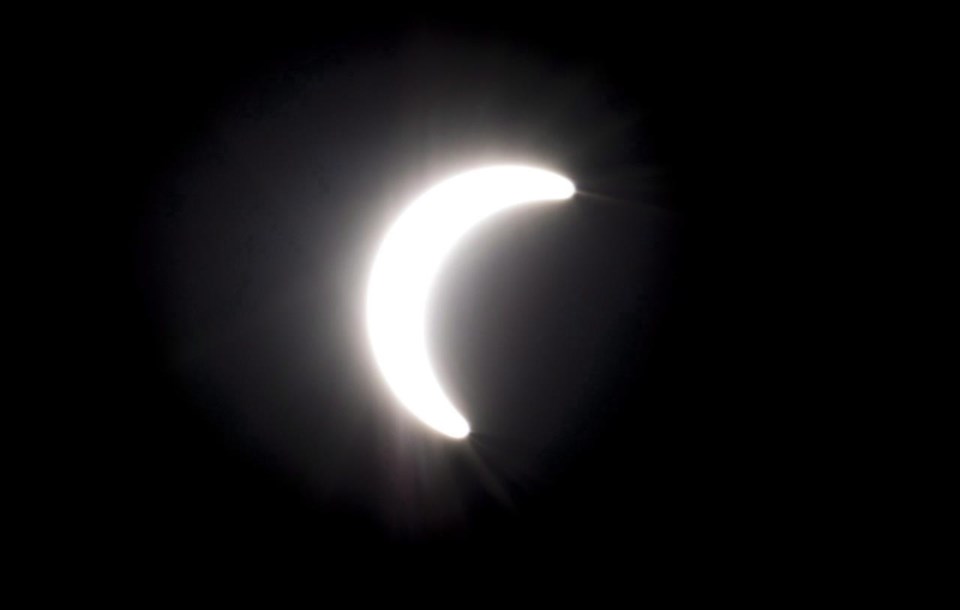Millions of people in parts of Eastern and Atlantic Canada will be able to see the rare solar eclipse happening on April 8. But they should only look up if they have proper eye protection, experts say.
WHY IS WATCHING THE ECLIPSE MORE DANGEROUS THAN LOOKING AT THE SUN ON A NORMAL DAY?
When people look up at the sun normally, the intense brightness triggers pain that causes them to look away quickly before it can cause damage, said Dr. Philip Hooper, president of the Canadian Ophthalmological Society.
But as the moon starts to block the sun in the period leading up to the total eclipse "there is significant light energy that's coming from the sun, but we don't appreciate pain. And so you can look at it long enough to do damage to the eye," said Hooper, who is also an associate professor of ophthalmology at Western University in London, Ont.
HOW DOES STARING AT THE SUN DAMAGE OUR EYES?
When you're looking directly at the sun, intense visible light and infrared radiation are focused on the centre of the retina in the back of the eye.
"It's basically like taking a magnifying glass in the sun on a normal day and focusing that light on a piece of paper. It can get hot enough to burn the paper," Hooper said.
The sun has the same effect, because your eye concentrates that energy into a small area of the retina.
"The temperature of the cells in that area can actually get high enough that the fluid in the cells actually boils and it damages the cells permanently," he said.
CAN I JUST PUT MY SUNGLASSES ON TO WATCH THE ECLIPSE?
No. Sunglasses do not provide protection, Hooper said.
WHAT IF I STAY INSIDE AND WATCH THROUGH THE WINDOW?
Again, no. Windows offer no protection.
IS IT SAFE TO WATCH THROUGH A PHONE CAMERA?
No.
"Eclipse or not, you shouldn't look at the sun directly with the naked eye, or with a camera or telescope, without a (certified) solar filter. This can lead to irreversible eye damage," says an eclipse safety video posted online by the Canadian Space Agency.
Pointing your phone camera directly at the eclipse may also have other consequences.
"Just remember that your camera on your phone has lenses just like eyeglasses do, and that light is coming in from the sun as soon as you open the shutter," said Elaina Hyde, director of the Allan I. Carswell Observatory at York University in Toronto.
"At the very least you could expect to damage your camera. You won't be able to see anything, again, because your phone is not able to handle that light."
HOW DO I SAFELY WATCH THE ECLIPSE?
You'll need special glasses with filters designed for eclipse watching, says the Canadian Space Agency website.
Those glasses must have side protection so that light rays can't enter, said Hooper.
They must also have certified lenses, he said.
The certificationISO 12312-2 should be printed on the glasses, whichmeans the glasses meet international safety standards.
While wearing the glasses, you should not be able to see anything unless you're staring at the sun.
"No matter how bright a light you are exposed to in your indoor environment, if you shone a very bright light through them, you'd see nothing. They're totally black. That's how dark they are," Hooper said.
The eclipse glasses should not be used if they are "scratched, punctured, torn, or otherwise damaged," the American Astronomical Society says on its website, noting that people should inspect their glasses before using them.
The society also says that children using the glasses during the eclipse must be supervised at all times.
WHERE CAN I GET THE ISO 12312-2 CERTIFIED GLASSES?
Free eclipse-viewing glasses are available at many libraries, cities and school districts across Canada, according to the Royal Astronomical Society of Canada website.
The American Astronomical Society has a list of companies and retailers in both Canada and the U.S. that sell certified solar eclipse glasses on its website.
Some companies selling them in Quebec are listed on the Eclipse Quebec website.
WHAT ABOUT WELDING GOGGLES?
Welding goggles come in a variety of shades, denoted by number, according to the Canadian Centre for Occupational Health and Safety website.
The minimum darkness required to safely watch the eclipse is shade 13, said Hooper.
"That's much darker than the welding glasses or goggles that are typically used by welders. And they're not widely available," he said.
IF I DON'T HAVE THE CERTIFIED GLASSES, IS THERE ANOTHER OPTION?
Another option for safe viewing is to make a projector so that you are never looking directly at the sun. It can be as basic as a piece of paper with a pinhole that projects the light from the sun onto the sidewalk, or a projector made out of a box.
The Canadian Space Agency website has simple instructions on how to make a projector using an empty cardboard box, a sheet of white paper, aluminum foil, a pin, tape and scissors.
For instructions, visit https://www.asc-csa.gc.ca/eng/youth-educators/activities/fun-experiments/eclipse-projector.asp
-With files from Sonja Puzic
This report by The Canadian Press was first published March 29, 2024.
Canadian Press health coverage receives support through a partnership with the Canadian Medical Association. CP is solely responsible for this content.
Nicole Ireland, The Canadian Press



